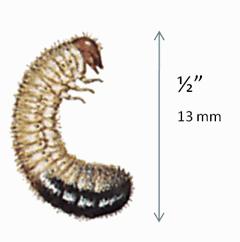|
Japanese Beetle
View more pictures: Bing Images Google Images Yahoo Images Common names: Japanese Beetle Scientific name: Popillia japonica Region: This beetle is primarily found in the eastern United States, but is making its way westward. It was first found in this country in 1916 around Riverton, New Jersey. The over 300 attractive plant species (mainly ornamentals) had encouraged its migration and can now be found in southern Maine, South Carolina, Georgia, Kentucky, Illinois, Michigan, and Missouri. Life cycle: The life cycle for this beetle is two years. Mature grubs overwinter deep within the soil and begin to move upward in the spring. Pupation occurs in early summer. The adult will feed from the middle of summer to fall, while laying its eggs in late summer.
Physical Description: This 1/2 inch long beetle is metallic blue or green with coppery wing covers and has two small patches of white hair on its abdomen and five patches on each side below the wing covers. The eggs are white and can be found to lie singularly or in groups in sod. The plump larva is grayish white with a brown head and is about 3/4 inch in length. Feeding characteristics: The adults destroy flowers and leaves, leaving only a skeleton where a leaf used to be. The period of greatest activity lasts from four to six weeks. Grubs feed on the roots and underground stems of plants, particularly grasses. The beetle often goes unnoticed until the plants begin to die. The adult beetles feed on more than 300 different plants and often feed on flowers, foliage, fruit, and trees exposed to strong sunlight. Controls: Nature itself places many controls on this beetle. Disease, weather, and birds are essential in keeping the numbers down. Bird predators include Starlings, Grackles, Cardinals, Catbirds, and Meadowlarks. There are five parasitic wasps that can control this beetle. Two of the most effective are the Tiphia vernalis and Tiphia popilliavora. The disease that is known to affect this pest is called Milky Spore Disease or Bacillus popilliae. The disease is harmless to humans, warm-blooded animals and plants, and is now sold in dust form. If only a few plants are troubled, then you might get by with handpicking them. If troubles are greater, then try spaying with rotenone spray as a last resort. Return from Japanese Beetle to Insects I-L Encyclopedia of Garden Insects |

